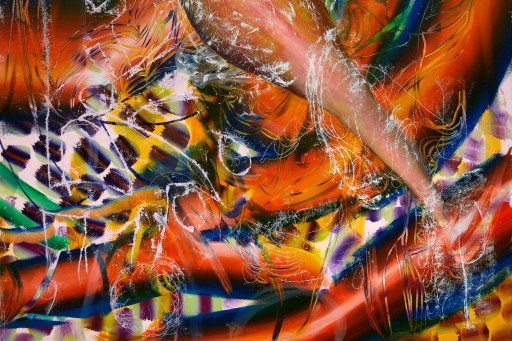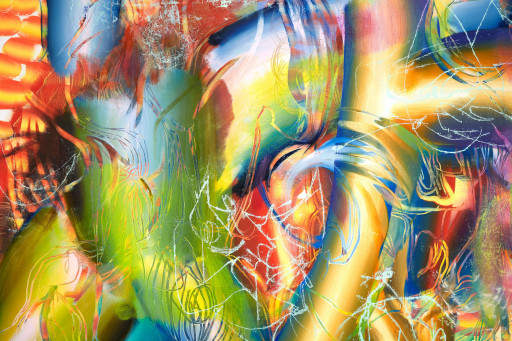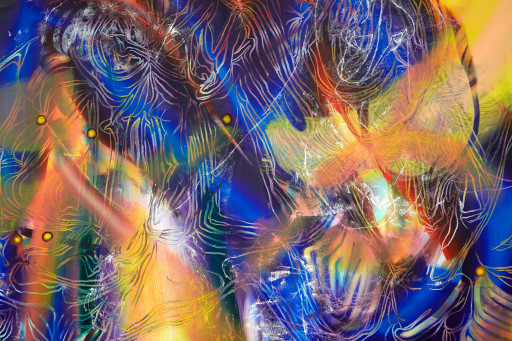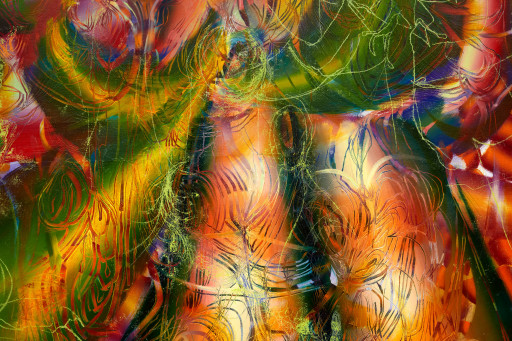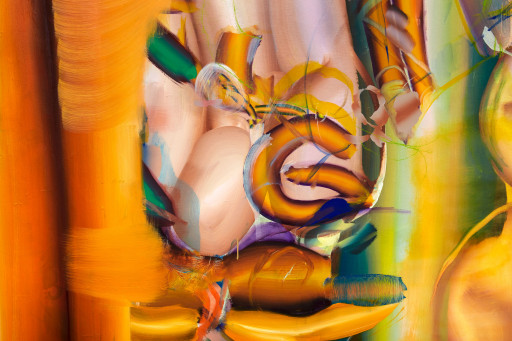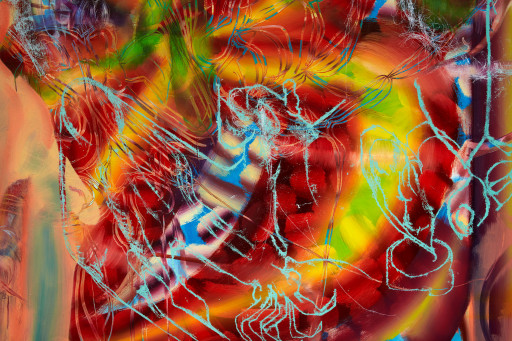Friends Indeed Gallery is pleased to present new works by Lauren Quin at Four One Nine in San Francisco's SoMA district.
“A dog devouring the stomach of a goose, a drunken vomiting woman, a slobbering accountant, a jar of mustard represent the confusion that serves as the vehicle of love [...] The planetary systems that turn in space like rapid disks, and whose centers also move, describing an infinitely larger circle, only move away continuously from their own position in order to return it, completing their rotation. Movement is a figure of love, incapable of stopping at a particular being, and rapidly passing from one to another. [...] Love and life appear to be separate only because everything on earth is broken apart by vibrations of various amplitudes and durations.” [1]
When the crackling register of vocal fry is detectable, chords are pushed below their registering limit causing a flap and flutter. Putting her canvases through a double-sided process and working with the formal components of tubes and tunnels, Lauren Quin’s paintings take on a surreal metaphor of throats. How do love and power move through these instruments of communication? As sites for exchange, throats and paintings host an exposed exterior for reception and consumption. Adopted by British men in the 1970’s in attempt to command authority, the creaking low-speak of vocal fry was co-opted by young women in The San Fernando Valley in the 1980’s and continues to be a site for gendered power negotiations to unfold. Like a regulating orifice, Quin’s painting surfaces open and close to emit orchestrated patterns.
Following a ‘one plus one equals three’ logic, where the tension between two patterns manifest a third, the sublime visual fry of moiré appears when identical overlapping patterns are slightly displaced or rotated to reveal an overlay of waving lines in distorted colors. The effect is difficult to describe then easy to spot, and is found in common everyday encounters; the distorted waves that appear when looking through two mesh fences from a moving perspective; throughout nature in the iridescent sheen of a fly’s eye or the merging of colors in a bird’s feather; and in the pixilated oil slick on a screen when delicate and repetitive details in a digital image exceed a monitor’s resolution. In the paintings, digital space has served more as a useful foil than direct reference. Not only is in-person viewing generously rewarded, but digital screens obfuscate the unique painting process as the scale of the stretching tubes can be mistranslated to the slight gesture of a cursor drag on screen. Scale, surface, and speed are only understood in their entirety at the bodily level. Like people, the paintings have digital selves. Though flattened on a screen in person their oily textures in nuanced shades celebrate the joyful nausea of life.
A mystical appeal of painting is renewed in the medium’s power to create something from nothing as pattern is translated to form on to which pattern is applied resulting in a psychedelic optical destabilization. By translating the marbled lines of the moiré pattern into dimensional snaking tubes and the radiating circles into portal-like tunnel spaces, these complementary forms work in tandem to build out the paintings’ electric biomorphic architectures. When perspectives are inverted from exterior to interior space, the long stalks and tubes are revealed to be equivalent to the holes, tunnels, passageways. Tangles of wet sockets wrestle across canvases.
In lieu of firm ground, their twisted gradient limbs grow around and cannibalize in on themselves. The flow’s sharp disruptions inspire somatic esophagus tension like liquid ‘going down the wrong pipe’. While some glossy worm-like segments struggle to connect, other passageways sputter out or are swallowed up.
Within the tubes and tunnels Quin pushes her fingers, brushes, and tools through the thin top layer of paint to distort and reveal contrasting patterns beneath. The snaking tube and tunnel forms (adapted from the pattern of whirling and radiating lines) are smeared and carved into the surface adorning the forms. Delicate dragging marks form a connective vibrating tissue in a pattern that’s at once floral and muscular. It is in these up-close details moiré is pushed to a point of linguistic and visual collapse becoming both noun and verb — object and action. In a chicken and egg scenario, the pattern within the form is retroactively the inspiration for the form. Quin’s exploration of simultaneous form and pattern is taken one step further in a third style of mark-making akin to a mono-print drawn from the back of the canvas resulting in a fizzling impression on the surface. With radiating auras, the drawings are repeatedly imposed in an echoed pattern, slightly vibrating away from and back into their source.
Lauren Quin (b. 1992) lives and works in Los Angeles. She graduated with an MFA from Yale School of Art in 2019, attended Skowhegan School of Painting and Sculpture, and earned her BFA from the School of the Art Institute of Chicago in 2015. She has previously exhibited at Real Pain Fine Arts (Los Angeles), Loyal (Stockholm), Smart Objects (Los Angeles), Downs and Ross (New York) and Blum and Poe (Los Angeles). Quin will be included in a group show at Unclebrother, a project by Gavin Brown and Rirkrit Tiravanija. She is in the collection of the ICA Miami.
— Marie Heilich, Los Angeles, 2021
[1] Excerpts from Bataille’s “The Solar Anus” or the Parody of Parodies
